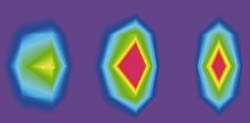
Dartmouth Medical School geneticists studying the biological clock have opened yet another window into the role of an unusual form of RNA known as antisense that blocks the messages of protein-encoding genes.
They found that antisense RNA appears to regulate core timing genes in the circadaian clock that drives the 24-hour light-dark cycle of Neurospora, a model organism better known as bread mold.
The results are reported in the February 27 Nature by Drs. Jennifer Loros and Jay C.

Scientists with the U.S. Department of Energy’s Joint Genome Institute (JGI) and the Lawrence Berkeley National Laboratory (Berkeley Lab) have developed a powerful new technique for deciphering biological information encoded in the human genome. Called “phylogenetic shadowing,” this technique enables scientists to make meaningful comparisons between DNA sequences in the human genome and sequences in the genomes of apes, monkeys, and other non-human primates. With phylogenetic shadowing, scientists c

For the first time, scientists have identified and analyzed single grains of silicate stardust in the laboratory. This breakthrough, to be reported in the Feb. 27 issue of Science Express, provides a new way to study the history of the universe.
“Astronomers have been studying stardust through telescopes for decades,” said first author Scott Messenger, Ph.D., senior research scientist in the Laboratory for Space Sciences at Washington University in St. Louis. “And they have derived models of wha

It is not known what genes turn leaves yellow in the fall. However, scientists at Umeå Plant Science Center, Umeå University, and the Royal Institute of Technology in Stockholm (KTH) have managed to identify more than 2,400 genes that take part in the process.
One of the most magnificent pageants of nature every year is when trees take on their autumn colors. Scientists have long known that these colors appear when the green pigment chlorophyll is broken down at the same time as the yellow c

p> Using a sensitive new imaging instrument on NASA’s Cassini spacecraft, researchers at The Johns Hopkins University Applied Physics Laboratory (APL) in Laurel, Md., have discovered a large and surprisingly dense gas cloud sharing an orbit with Jupiter’s icy moon Europa.
Stretching millions of miles around Jupiter, the donut-shaped cloud, known as a “torus,” is believed to result from the uncommonly severe bombardment of ion radiation that Jupiter sends toward Europa. That radiatio

In studies using rats, researchers from Duke University Medical Center (USA) and Imperial College London, have found evidence that the chemically inert gas xenon can protect the brain from the neurological damage often associated with the use of the heart-lung machine during coronary artery bypass surgery.
The researchers say that xenon appears to block receptors on nerve cells in the brain that can be “overstimulated” in response to the surgery. This overstimulation can lead to ner

– new calculation confirms standard model of particle physics. Contribution of hadronic vacuum polarization determined with unprecedented accuracy. The magnetic moment of the muon is an important precision parameter for…
Technique may prevent formation of unwanted waves that siphon off needed energy. Heating plasma to the ultra-high temperatures needed for fusion reactions requires more than turning the dial on a…

An international team of astronomers, led by researchers from the Astronomical Observatory of the University of Warsaw, have identified a new class of cosmic X-ray sources. The findings have been…

Antibody that Neutralizes Inhibitory Factors Involved in Nerve Regeneration Leads to Enhanced Motor Function after Acute Spinal Cord Injury. Researchers at 13 clinics in Germany, Switzerland, the Czech Republic and…

How the body’s natural killer cells could fight leukemia. Every year, some 13,000 people in Germany are diagnosed with leukemia. Despite intensive chemotherapy, around one in two of them die….

… eco-friendly reactor converts air and water into ammonia. Producing enough ammonia to feed the world comes with a large carbon footprint;. process described in new UB-led study could help…

How simulations help manufacturing of modern displays. Modern materials must be recyclable and sustainable. Consumer electronics is no exception, with organic light-emitting diodes (OLEDs) taking over modern televisions and portable…

“Neurons that fire together, wire together” describes the neural plasticity seen in human brains, but neurons grown in a dish don’t seem to follow these rules. Neurons that are cultured…

The quest for sustainable energy solutions has been a major focus of scientific research for decades. Solar energy, a clean and renewable source, has emerged as a promising alternative to…

With a processing speed a billion times faster than nature, chip-based laser neuron could help advance AI tasks such as pattern recognition and sequence prediction. Researchers have developed a laser-based…

New technology could remotely identify various types of plastics, offering a valuable tool for future monitoring and analysis of oceanic plastic pollution. Researchers have developed a new hyperspectral Raman imaging…

Artificial Intelligence (AI) has established a strong presence across industries, large and small. The “VoBaKI” research project has empowered small and medium-sized enterprises (SMEs) with an innovative tool to independently…